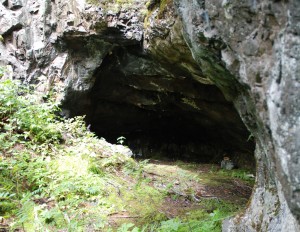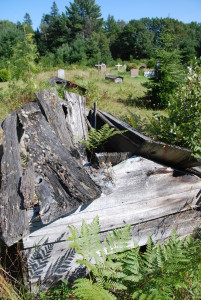Native Icons – Wawa and Garden River (Sault Ste. Marie)
Medicine Cave –Time and Place –Natural and Cultural Heritage
by Back Roads Bill
It is sometimes difficult to comprehend timelines with millions of years and then relate to the covenants of religion beyond what you know and practice.
Time and religion, you would think these don’t fit together but at this next location, one is the reason for the other.
For Native communities the relationship with the land and time is important to their heritage. It is hard to believe the Northern Ontario landscape was once covered by a huge inland sea. The rise and fall of the Great Lakes created some features that are truly unusual. Some of these physical anomalies were utilized by early Native cultures for very different reasons.
As time goes by recalling specific events within our own lives is sometimes difficult. Putting geomorphologic time in perspective becomes more abstract.
Amongst many episodes, during the Paleozoic Era (about 540 million to 250 million years ago), large parts of Canada were covered by shallow seas. Sediments deposited in these seas formed the sandstone, shale, and limestone that now surround the Canadian Shield. When you reach this destination think of the forces, greater even than what we know created the Great Lakes, that formed this sea cave; waves seething at the rock face of an ancient coastline.
Sea caves are formed by the power of the ocean attacking zones of weakness in coastal sea cliffs. The weak zone is usually a fault, or fractured zone formed during slippage. This is most likely the cause of the formation of this cave.
The People and the Land
This resulting physical feature became a vision quest destination for an earlier Native culture, a medicine cave.
The Ojibwa are an ethno linguistic First Nations group centered about Lake Superior and Lake Huron. A series of migrations eventually created a traditional territory inherent to most Native cultures. . Cultural heritage tells more of a people’s relationship with nature.
For the Ojibwa the meaning of life was understood through their comprehension of creation. They believed Kitchi-Manitou had created the universe and everything in it. They also knew that Manitou had given an imaginative foresight – an ability to create a future that is not pre-ordained as we might know it. There was the capacity to dream – to have a vision of one’s position in the universe. A vision of what he might do with the life given him. It seemed to be more of male prerogative. And with that gift of vision came the moral responsibility for each person to discover his own purpose and bring that revelation into existence.
When you visit the cave think about the Medicine Wheel. The Medicine Wheel is one of the most important teachings of the Anishinabe (Ojibway), and includes other teachings, such as the four directions (north, east, south, west), the four colors of the races of man (red, black, white and yellow), and the four stages of life (spiritual, mental, physical and emotional).
A vision quest is simply a search for the meaning and purpose of life, related to the Medicine Wheel. It’s one of the reasons any religion exists. Throughout the millennia humankind has hoped that life is more than just survival and eventually death. There has always been the need to search for some sort of significant spirituality that guides us beyond just our physical existence. In the days of the Native Medicine Man, particularly youth, seeking guidance, would travel to remote destinations. These vision quest sites would often be promontories, cliffs or caves. These physical sites were created through the movement of land and water through geomorphologic time. You will read about other spiritual locations within .steertonorthernontario.ca .
The Anishnabe have a saying: “No person begins to be until they have seen their vision.” It means more than just surviving but working towards determining a meaningful purpose to one’s life. It means to understand, to work out the meaning within one’s breadth and depth of life; time and spirituality, working together for a purpose.
Access
You will drive five km south of Wawa on Highway 17 and find the road heading west to Michipicoten Harbour. Drive about 1 km you will come to an intersection. Turn right, drive over the small wooden bridge and then you will take a sweeping left, leaving the houses behind. You will come to Silver Falls, there are actually three falls here to see, one above and below the one you actually see! Drive on past the cemeteries…there is a sweeping curve to the right and you will come to a left-hand turn leading to Superior Adventures…this is heading west. Start to slow down, you will pass a small rock cut and see some utility poles paralleling the road. Look carefully, to the north or right for the small trail entrance, it is hard to spot (N47° 56’ 18.2” W84° 50’ 26.9” WGS 84 Zone 16 T 661254 5311708). The walk in is about 250 m. Park down the road a ways… if you come to the next driveway/road on the right/north you have gone too far.
The Medicine Cave is a ceremonial location for the Michipicoten First Nation. It is a place to tread lightly. The location is not well known. Once you have located the trail please safely park well down the road, a couple or more of utility pole lengths away.
It’s very difficult to write about ‘Native Spirituality’. It is a study within itself. You need to believe and practice a religion if you really want to talk about it. The appreciation comes with the relationship native spirituality has “with “nature.
Spirit Houses
by Back Roads Bill
A cemetery is a quiet place; much contemplation can take place there.
A visit encourages an appreciation of the unique historical significance of that particular place or people. It can reveal much about the lives of people of the past. Once there you can enjoy the tranquility of the setting.
The Native cemetery you will visit has a setting amongst towering white pine trees and allows for the respect and understanding of earlier and others’ traditions. There is something symbolic at this cemetery that is mystical and relevant.
In many older cemeteries you will see physical customs that have evolved from many religions including pagan rituals. These may include burials on high hills or slopes which predate Christianity; evergreens, such as cedar (the tree of death) planted at the burial site; the body placed east and west (feet east); the wife buried to the south of the husband. In Anishinabek (our first people) culture it is believed you entered the world through the eastern gateway and departed through the west.
Spirits Houses
We may be most familiar with the “sweat lodge” or purification lodge. It uses heated stones (Grandfathers) to bring the Creator’s fire into a small framed structure that is the Womb of the Earthly Mother, where water is poured on them, releasing wisdom and healing power through steam.
In some Native cemeteries you may see a small wooden house built over a grave in the form of a small shelter covering the plot. The grave house or “spirit house” is a tradition known among many North American tribes including those of Northern Ontario. After interment, a spirit house is built and a spirit plate is offered to house and feed the spirit, which may remain after death while preparing to depart to the Land of Souls. There may be bird symbols present because they are seen as the receptacles for the souls of the dead. Essentially, the bird is symbolic of the freedom and immortality of the soul. A person’s personal possessions are buried with the body. They include a medicine bundle, a bowl and spoon with some corn, tobacco and pipe if the person had one. This is so that the soul is welcomed to the afterlife.
Within past Native traditions many believed the spirits of their ancestors lived among them today. A spirit house is seen as a “spirit house” for the deceased. This is also seen among Europeans in both Pre-Christian pagan religions and Christian Roman Catholic beliefs such as purgatory. Several different practices revolve around Native funeral traditions and developed over time. Some include, leaving personal possessions at the grave site, food, tobacco or cedar to ward off evil spirits. One of the main functions indigenous beliefs shares with mythology in general is the construction of a symbolic world in which the individual can feel familiar, safe and comfortable. The spirit house is more than a symbol.
Some purposes for a spirit house include: keeping wild animals off the graves, the cemetery may not be fenced off. The spirit house also keeps rain off the grave; provides a distinct memorial to loved one; gives comfort to the spirit of the dead and provides a home for the spirit of the dead. Considering the above it should not be a surprise that Native customs and practices are as important then, as now.
Access
Garden River First Nation is located just east of Sault Ste. Marie. With the new bypass you must take old Highway 17 to Garden River from the “Soo” end (west) or from the Echo Bay end (east).
From the “Soo” end it is 5.3 km east to Bell St. and the large church on the corner. Go south past the mail boxes 0.3 km and turn right on to Pt. Charles Rd., go south approximately 1 km to the cemetery on the left or east side (WGS 84 Zone 16 T 717733 5157407 or N 46° 32’ 05.9’ W 84° 09’ 37.9” ).
Return to the fork and turn on to Wahgoosh St. , then left on Park Rd., 0.3 km to the cemetery amongst the large white pine trees ( 16 T 717550 5157125 or N46° 31’ 57.0 “ W84° 09’ 47.0”). One cemetery seems to be more utilized than the other and both are different denominations.
Death remains one of life’s greatest mysteries. Religions offer a variety of answers. Their explanations often contradict one another, adding to the confusion and uncertainty about what could happen after death. Many beliefs teach that people are born with immortal souls; some say people are immortal souls. Many believe that after death the soul is conscious and proceeds to a literal place or condition of bliss or torment. Others teach that upon death the soul is absorbed into a “greater consciousness.” Some expect to be reincarnated, coming back to earth as another person or as an animal. The visit to the spirit houses will create a new respect for what others believe in and allow you to consider your own.


